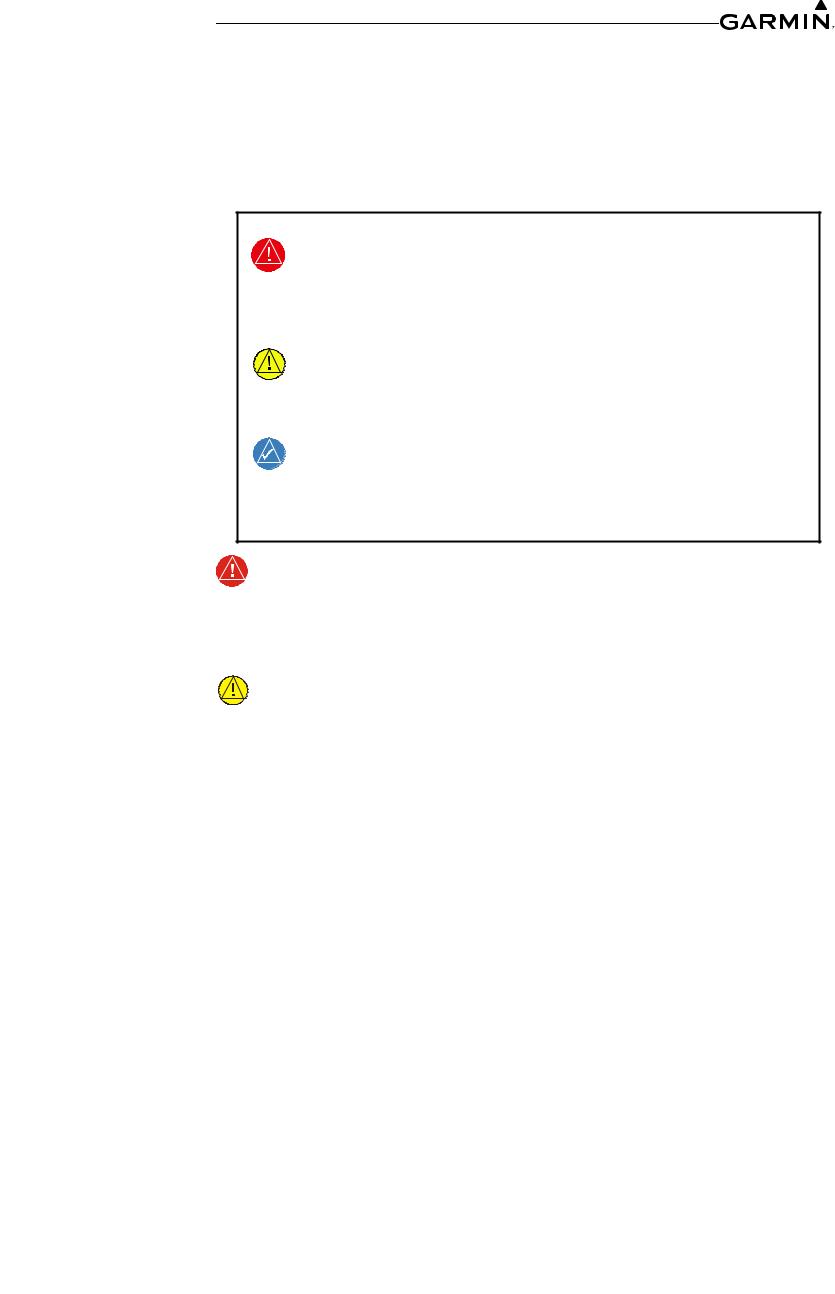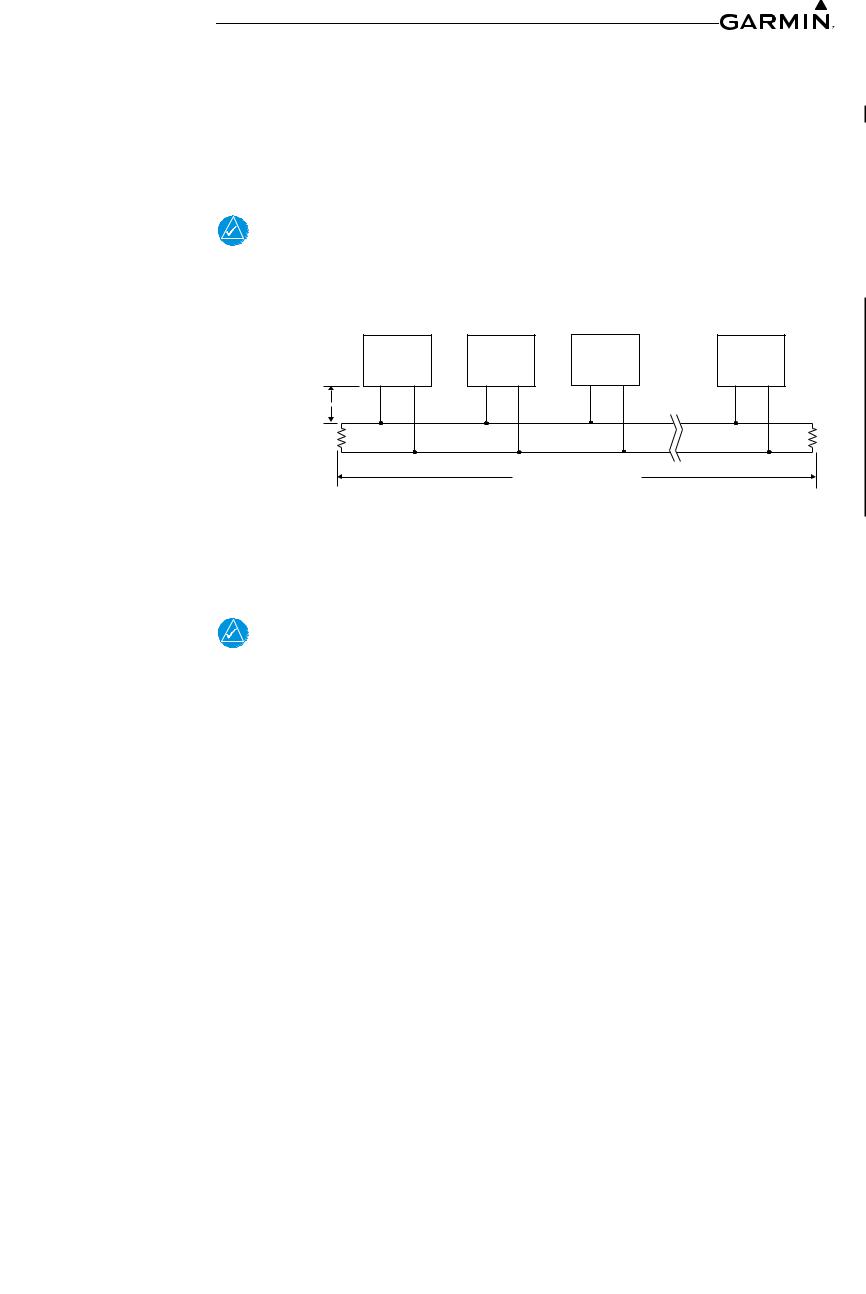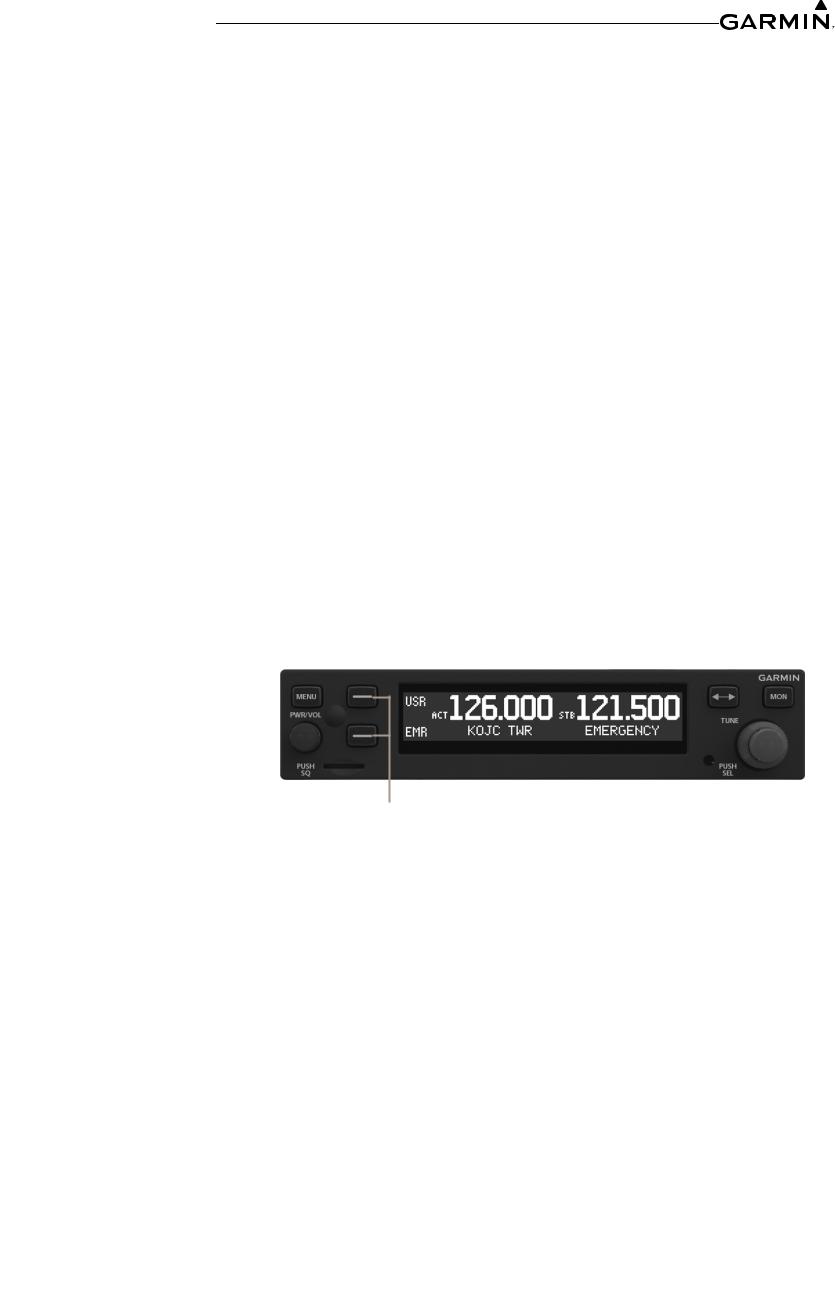Garmin GTR 200 Installation Manual

GTR 200
COM Transceiver
Installation Manual
190-01553-00 |
February, 2015 |
Revision G |

© 2015
Garmin Ltd. or its subsidiaries All Rights Reserved
Except as expressly provided herein, no part of this manual may be reproduced, copied, transmitted, disseminated, downloaded or stored in any storage medium, for any purpose without the express prior written consent of Garmin. Garmin hereby grants permission to download a single copy of this manual and of any revision to this manual onto a hard drive or other electronic storage medium to be viewed and to print one copy of this manual or of any revision hereto, provided that such electronic or printed copy of this manual or revision must contain the complete text of this copyright notice and provided further that any unauthorized commercial distribution of this manual or any revision hereto is strictly prohibited.
Garmin International, Inc.
1200 E. 151st Street
Olathe, KS 66062 USA
Telephone: 913.397.8200
Aviation Panel-Mount Technical Support Line (Toll Free) 1.888.606.5482
www.garmin.com
Garmin (Europe) Ltd.
Liberty House, Hounsdown Business Park
Southampton, Hampshire SO40 9LR U.K.
+44/ (0) 23 8052 4000
|
|
|
|
|
|
|
|
Garmin AT, Inc. |
|
|
|
|
|
|
|
|
2345 Turner Rd., SE |
|
|
|
|
|
|
|
Salem, OR 97302 USA |
|
|
|
|
|
|
|
Telephone: 503.581.8101 |
||
|
|
|
|
|
RECORD OF REVISIONS |
|||
|
|
|
|
|
|
|
|
|
Revision |
|
Revision Date |
|
|
Description |
|||
|
|
|
|
|
|
|
|
|
A |
|
|
07/19/13 |
|
|
Initial Release |
||
|
|
|
|
|
|
|
|
|
B |
|
|
09/11/13 |
|
|
Corrected panel cutout drawing Fig C-4 |
||
|
|
|
|
|
|
|
|
|
C |
|
|
01/08/14 |
|
|
Updated to include new SW features |
||
|
|
|
|
|
|
|
|
|
D |
|
|
04/15/14 |
|
|
Updated to include CAN bus capability |
||
|
|
|
|
|
|
|
|
|
E |
|
|
10/14/14 |
|
|
Updated squelch description and corrected ID pin description |
||
|
|
|
|
|
|
|
|
|
F |
|
|
12/15/14 |
|
|
Made corrections to interconnect drawings |
||
|
|
|
|
|
|
|
|
|
G |
|
|
02/13/15 |
|
|
Updated maximum CAN node length |
||
|
|
|
|
|
|
|
|
|
|
|
|
|
|
CURRENT REVISION DESCRIPTION |
|||
|
|
|
|
|
|
|
|
|
Revision |
|
Page |
|
Section |
|
|
Description of Change |
|
|
Number(s) |
Number |
|
|
||||
|
|
|
|
|
||||
|
|
|
|
|
|
|
|
|
G |
|
2-5 |
|
2.7.2 |
|
|
Updated maximum CAN node length |
|
|
|
|
|
|
|
|
|
|
|
D-3 |
|
Appdx D |
Updated max CAN node length in Figure D-2 and Figure D-6 |
||||
|
|
|
||||||
|
|
|
|
|
|
|
|
|
190-01553-00 |
GTR 200 Installation Manual |
Rev. G |
Page A |

INFORMATION SUBJECT TO EXPORT CONTROL LAWS
This document may contain information which is subject to the Export Administration Regulations ("EAR") issued by the United States Department of Commerce (15 CFR, Chapter VII, Subchapter C) and which may not be exported, released, or disclosed to foreign nationals inside or outside of the United States without first obtaining an export license. The preceding statement is required to be included on any and all reproductions in whole or in part of this manual.
DEFINITIONS OF WARNINGS, CAUTIONS, AND NOTES
WARNING
Warnings are used to bring to the installer’s immediate attention that not only damage to the equipment but personal injury may occur if the instruction is disregarded.
CAUTION
Cautions are used to alert the individual that damage to equipment may result if the procedural step is not followed to the letter.
NOTE
Notes are used to expand and explain the preceding step and provide further understanding of the reason for the particular operation.
WARNING
This product, its packaging, and its components contain chemicals known to the State of California to cause cancer, birth defects, or reproductive harm. This Notice is being provided in accordance with California's Proposition 65. If you have any questions or would like additional information, please refer to our web site at www.garmin.com/prop65.
CAUTION
The front bezel, keypad, and display can be cleaned with a microfiber cloth or with a soft cotton cloth dampened with clean water. DO NOT use any chemical cleaning agents. Care should be taken to avoid scratching the surface of the display.
190-01553-00 |
GTR 200 Installation Manual |
|
Rev. G |
Page i |
|

Aviation Limited Warranty
All Garmin avionics products are warranted to be free from defects in materials or workmanship for: two years from the date of purchase for new Remote-Mount and Panel-Mount products; one year from the date of purchase for new portable products and any purchased newly-overhauled products; six months for newly-overhauled products exchanged through a Garmin Authorized Service Center; and 90 days for factory repaired or newly-overhauled products exchanged at Garmin in lieu of repair. Within the applicable period, Garmin will, at its sole option, repair or replace any components that fail in normal use. Such repairs or replacement will be made at no charge to the customer for parts or labor, provided that the customer shall be responsible for any transportation cost. This warranty does not apply to: (i) cosmetic damage, such as scratches, nicks and dents; (ii) consumable parts, such as batteries, unless product damage has occurred due to a defect in materials or workmanship; (iii) damage caused by accident, abuse, misuse, water, flood, fire, or other acts of nature or external causes; (iv) damage caused by service performed by anyone who is not an authorized service provider of Garmin; or (v) damage to a product that has been modified or altered without the written permission of Garmin. In addition, Garmin reserves the right to refuse warranty claims against products or services that are obtained and/or used in contravention of the laws of any country.
THE WARRANTIES AND REMEDIES CONTAINED HEREIN ARE EXCLUSIVE AND IN LIEU OF ALL OTHER WARRANTIES, WHETHER EXPRESS, IMPLIED OR STATUTORY, INCLUDING ANY LIABILITY ARISING UNDER ANY WARRANTY OF MERCHANTABILITY OR FITNESS FOR A PARTICULAR PURPOSE, STATUTORY OR OTHERWISE. THIS WARRANTY GIVES YOU SPECIFIC LEGAL RIGHTS, WHICH MAY VARY FROM STATE TO STATE.
IN NO EVENT SHALL GARMIN BE LIABLE FOR ANY INCIDENTAL, SPECIAL, INDIRECT OR CONSEQUENTIAL DAMAGES, WHETHER RESULTING FROM THE USE, MISUSE OR INABILITY TO USE THE PRODUCT OR FROM DEFECTS IN THE PRODUCT. SOME STATES DO NOT ALLOW THE EXCLUSION OF INCIDENTAL OR CONSEQUENTIAL DAMAGES, SO THE ABOVE LIMITATIONS MAY NOT APPLY TO YOU.
Garmin retains the exclusive right to repair or replace (with a new or newly-overhauled replacement product) the product or software or offer a full refund of the purchase price at its sole discretion. SUCH REMEDY SHALL BE YOUR SOLE AND EXCLUSIVE REMEDY FOR ANY BREACH OF WARRANTY.
Online Auction Purchases: Products purchased through online auctions are not eligible for warranty coverage. Online auction confirmations are not accepted for warranty verification. To obtain warranty service, an original or copy of the sales receipt from the original retailer is required. Garmin will not replace missing components from any package purchased through an online auction.
International Purchases: A separate warranty may be provided by international distributors for devices purchased outside the United States depending on the country. If applicable, this warranty is provided by the local in-country distributor and this distributor provides local service for your device. Distributor warranties are only valid in the area of intended distribution. Devices purchased in the United States or Canada must be returned to the Garmin service center in the United Kingdom, the United States, Canada, or Taiwan for service.
Garmin International, Inc. |
Garmin (Europe) Ltd. |
1200 East 151st Street |
Liberty House, Hounsdown Business Park |
Olathe, Kansas 66062, U.S.A. |
Southampton, Hampshire SO40 9LR U.K. |
Phone: 913/397.8200 |
Phone: +44 (0) 23 8052 4000 |
Fax: 913/397.0836 |
Fax: +44 (0) 23 8052 4004 |
|
Aviation Support: +44 (0) 87 0850 1243 |
|
|
190-01553-00 |
GTR 200 Installation Manual |
Rev. G |
Page ii |

TABLE OF CONTENTS
PARAGRAPH PAGE
Section 1 General Description ........................................................................... |
1-1 |
|
1.1 |
Introduction...................................................................................................................... |
1-1 |
1.2 |
Equipment Description .................................................................................................... |
1-1 |
1.3 |
Technical Specifications .................................................................................................. |
1-2 |
1.4 |
Certification ..................................................................................................................... |
1-5 |
1.5 |
Reference Documents ...................................................................................................... |
1-5 |
Section 2 Installation Overview......................................................................... |
2-1 |
|
2.1 |
Introduction...................................................................................................................... |
2-1 |
2.2 |
Unit Configurations ......................................................................................................... |
2-1 |
2.3 |
Available Accessories...................................................................................................... |
2-1 |
2.4 |
Installation Considerations .............................................................................................. |
2-2 |
2.5 |
Antenna Considerations................................................................................................... |
2-2 |
2.6 |
Mounting Considerations................................................................................................. |
2-4 |
2.7 |
Cabling and Wiring.......................................................................................................... |
2-4 |
2.8 |
Air Circulation and Cooling ............................................................................................ |
2-6 |
2.9 |
Compass Safe Distance.................................................................................................... |
2-6 |
Section 3 Installation Procedures ...................................................................... |
3-1 |
|
3.1 |
Unpacking the unit........................................................................................................... |
3-1 |
3.2 |
Wiring Harness Installation ............................................................................................. |
3-1 |
3.3 |
Backshell Assembly......................................................................................................... |
3-2 |
3.4 |
Mounting Requirements .................................................................................................. |
3-2 |
3.5 |
Antenna Installation and Connections ............................................................................. |
3-3 |
3.6 |
Post Installation Configuration and Checkout Procedures .............................................. |
3-4 |
3.7 |
Unit Software................................................................................................................. |
3-20 |
3.8 |
Continued Airworthiness ............................................................................................... |
3-22 |
Section 4 Connector Pinout Information.......................................................... |
4-1 |
|
4.1 |
Pin Function List.............................................................................................................. |
4-1 |
4.2 |
Power ............................................................................................................................... |
4-2 |
4.3 |
Lighting Bus .................................................................................................................... |
4-2 |
4.4 CAN Bus.......................................................................................................................... |
4-3 |
|
4.5 |
Unit ID ............................................................................................................................. |
4-3 |
4.6 |
Serial Data – RS-232 ....................................................................................................... |
4-4 |
4.7 |
MIC Audio....................................................................................................................... |
4-4 |
4.8 Aux Mono Audio ............................................................................................................. |
4-5 |
|
4.9 |
Headset Audio.................................................................................................................. |
4-5 |
4.10 Music Inputs .................................................................................................................. |
4-5 |
|
4.11 Receiver Audio .............................................................................................................. |
4-6 |
|
190-01553-00 |
GTR 200 Installation Manual |
Rev. G |
Page iii |

PARAGRAPH |
PAGE |
|
4.12 |
Pilot/Copilot PTT Inputs |
................................................................................................ 4-6 |
4.13 |
TX Interlock................................................................................................................... |
4-6 |
4.14 |
Discrete Inputs ............................................................................................................... |
4-7 |
Appendix A Shield Block Connector Installation Instructions |
.....................A-1 |
|
A.1 |
Shield Block Installation Parts....................................................................................... |
A-1 |
A.2 |
Shield Termination Technique – Method A.1 (Standard) ............................................. |
A-3 |
A.3 |
Shield Termination Technique - Method A.2 (Daisy Chain) ........................................ |
A-7 |
A.4 |
Shield Termination – Method B.1 (Quick Term) .......................................................... |
A-7 |
A.5 |
Shield Termination-Method B.2 (Daisy Chain-Quick Term)........................................ |
A-9 |
A.6 |
Daisy Chain between Methods A and B ...................................................................... |
A-10 |
A.7 |
Splicing Signal Wires .................................................................................................. |
A-10 |
Appendix B |
Serial Interface Specifications..................................................... |
B-1 |
|
B.1 |
Electrical Interface .......................................................................................................... |
B-1 |
|
B.2 |
Message Formats............................................................................................................. |
B-1 |
|
Appendix C |
Outline and Installation Drawings ............................................. |
C-1 |
|
Appendix D |
Interconnect Examples ................................................................ |
D-1 |
|
190-01553-00 |
GTR 200 Installation Manual |
|
Rev. G |
Page iv |
|

LIST OF FIGURES
FIGURE |
|
|
PAGE |
Section 1 |
General Description ........................................................................... |
1-1 |
|
Section 2 |
Installation Overview......................................................................... |
2-1 |
|
Figure 2-1 CAN Bus Configuration...................................................................................... |
2-5 |
||
Section 3 |
Installation Procedures ...................................................................... |
3-1 |
|
Figure 3-1 GTR 200 Front Panel .......................................................................................... |
3-4 |
||
Figure 3-2 Configuration Mode Home Page ........................................................................ |
3-5 |
||
Figure 3-3 COM Setup Page................................................................................................. |
3-7 |
||
Figure 3-4 |
ICS Sidetone Selection........................................................................................ |
3-7 |
|
Figure 3-5 MON Swap Selection.......................................................................................... |
3-8 |
||
Figure 3-6 Audio Setup Page (AUX and Music Disabled) .................................................. |
3-9 |
||
Figure 3-7 Audio Setup Page (AUX and Music Enabled).................................................... |
3-9 |
||
Figure 3-8 |
Softkey Setup Page ........................................................................................... |
3-10 |
|
Figure 3-9 |
Discrete Setup Page .......................................................................................... |
3-11 |
|
Figure 3-10 |
Lighting Setup Page ........................................................................................ |
3-12 |
|
Figure 3-11 |
Lighting Graph................................................................................................ |
3-13 |
|
Figure 3-12 RS-232 Status Page......................................................................................... |
3-13 |
||
Figure 3-13 |
Headset Tests Page.......................................................................................... |
3-14 |
|
Figure 3-14 COM Tests Page ............................................................................................. |
3-15 |
||
Figure 3-15 Audio Tests Page ............................................................................................ |
3-16 |
||
Figure 3-16 About Page...................................................................................................... |
3-20 |
||
Figure 3-17 Software Update Page..................................................................................... |
3-20 |
||
Figure 3-18 |
Micro SD Insertion.......................................................................................... |
3-21 |
|
Figure 3-19 Software Update Page - Scanning Card.......................................................... |
3-21 |
||
Figure 3-20 Software Update Page - No Update Found..................................................... |
3-22 |
||
Figure 3-21 Software Update Page - Update Software?..................................................... |
3-22 |
||
Figure 3-22 Software Update Page - Preparing Update...................................................... |
3-22 |
||
Figure 3-23 Software Update Page - Unit Will Reboot...................................................... |
3-22 |
||
Section 4 Connector Pinout Information.......................................................... |
4-1 |
||
Figure 4-1 |
J2001 Looking at rear of unit.............................................................................. |
4-1 |
|
Figure 4-2 CAN Bus Termination for GTR 200................................................................... |
4-3 |
||
Appendix A Shield Block Connector Installation Instructions..................... |
A-1 |
||
Figure A-1 Shield Block Install onto a Backshell .............................................................. |
A-2 |
||
Figure A-2 Method A.1 for Shield Termination................................................................. |
A-3 |
||
Figure A-3 |
Insulation/Contact Clearance ........................................................................... |
A-5 |
|
Figure A-4 Method A.2 (Daisy Chain) for Shield Termination ......................................... |
A-7 |
||
190-01553-00 |
GTR 200 Installation Manual |
|
Rev. G |
Page v |
|

FIGURE |
PAGE |
Figure A-5 Method B.1 (Quick Term) for Shield Termination.......................................... |
A-8 |
Figure A-6 Method B.2 (Daisy Chain-Quick Term) for Shield Termination..................... |
A-9 |
Figure A-7 Daisy Chain between Methods A and B ........................................................ |
A-10 |
Figure A-8 D-Sub Spliced Signal Wire illustration.......................................................... |
A-11 |
Appendix B Serial Interface Specifications .................................................... |
B-1 |
Appendix C Outline and Installation Drawings ............................................. |
C-1 |
Figure C-1 GTR 200 Outline Drawing ................................................................................. |
C-1 |
Figure C-2 GTR 200 Assembly Drawing ............................................................................. |
C-2 |
Figure C-3 GTR 200 Installation Drawing ........................................................................... |
C-3 |
Figure C-4 GTR 200 Panel Cutout Drawing ........................................................................ |
C-4 |
Appendix D Interconnect Examples ................................................................ |
D-1 |
Figure D-1 GTR 200 Interconnect Example Notes ............................................................. |
D-1 |
Figure D-2 GTR 200Power & Ground/Intercom/GDU 37X/46X CAN Bus |
|
Interconnect Example ........................................................................................................... |
D-2 |
Figure D-3 GTR 200Power & Ground/Intercom/GDU 37X RS-232 Interconnect |
|
Example ................................................................................................................................ |
D-3 |
Figure D-4 GTR 200Power & Ground/GMA 240/GNS 430/aera 79X Interconnect |
|
Example ................................................................................................................................ |
D-4 |
Figure D-5 GTR 200Mono Audio/Remote Mount Jack Interconnect Example ............... |
D-5 |
Figure D-6 GTR 200/CAN Bus Interconnect Drawing ....................................................... |
D-6 |
Figure D-7 Dual GTR 200/GMA 240 Interconnect Drawing.............................................. |
D-7 |
Figure D-8 GTR 200J2001 Connector Layout.................................................................. |
D-8 |
190-01553-00 |
GTR 200 Installation Manual |
Rev. G |
Page vi |

|
LIST OF TABLES |
TABLE |
PAGE |
Section 1 General Description ........................................................................... |
1-1 |
|
Table 1-1 |
Available Units..................................................................................................... |
1-1 |
Table 1-2 |
Physical Characteristics........................................................................................ |
1-2 |
Table 1-3 |
General Specifications.......................................................................................... |
1-2 |
Table 1-4 |
Display Specifications.......................................................................................... |
1-3 |
Table 1-5 |
COM Transmitter Specifications.......................................................................... |
1-3 |
Table 1-6 COM Receiver Specifications .............................................................................. |
1-4 |
|
Table 1-7 FCC Grant of Equipment Authorization .............................................................. |
1-5 |
|
Table 1-8 Reference Documents........................................................................................... |
1-5 |
|
Section 2 Installation Overview......................................................................... |
2-1 |
|
Table 2-1 |
Catalog Part Numbers .......................................................................................... |
2-1 |
Table 2-2 |
Standard Kit Accessories...................................................................................... |
2-1 |
Table 2-3 |
Contents of Connector Kit (011-03240-00), see Figure C-2................................ |
2-1 |
Table 2-4 |
Optional Accessories............................................................................................ |
2-2 |
Section 3 Installation Procedures ...................................................................... |
3-1 |
|
Table 3-1 |
Recommended Crimp Tools (or Equivalent) ....................................................... |
3-1 |
Table 3-2 |
Socket Contact Part Numbers............................................................................... |
3-1 |
Table 3 - 3 |
Configuration Default Settings............................................................................. |
3-6 |
Table 3-4 |
COM Setup Page Selections................................................................................. |
3-7 |
Table 3 - 5 |
Audio Setup Page Selections................................................................................ |
3-9 |
Table 3 - 6 |
Softkey Setup Page Selections ........................................................................... |
3-10 |
Table 3 - 7 |
Discrete Setup Page Selections .......................................................................... |
3-11 |
Table 3 - 8 |
Lighting Setup Page Selections.......................................................................... |
3-12 |
Table 3 - 9 |
Audio Tests Source Selections ........................................................................... |
3-16 |
Table 3 - 10 |
Discrete Inputs.................................................................................................. |
3-17 |
Table 3 - 11 |
TX Interlock Connections ................................................................................ |
3-18 |
Section 4 Connector Pinout Information.......................................................... |
4-1 |
|
Table 4-1 J2001 Connector................................................................................................... |
4-1 |
|
Appendix A |
Shield Block Connector Installation Instructions .................... |
A-1 |
Table A-1 |
Parts not supplied for a Shield Block Installation (Figure A-1)......................... |
A-1 |
Table A-2 |
Shielded Cable Preparations for Garmin Connectors......................................... |
A-3 |
Table A-3 |
Shielded Cable Preparations – (Quick Term)..................................................... |
A-9 |
Appendix B |
Serial Interface Specifications .................................................... |
B-1 |
Appendix C |
Outline and Installation Drawings ............................................ |
C-1 |
Appendix D |
Interconnect Examples ............................................................... |
D-1 |
190-01553-00 |
GTR 200 Installation Manual |
Rev. G |
Page vii |

1 GENERAL DESCRIPTION
1.1 Introduction
This manual is intended to provide mechanical and electrical information for use in the planning and design of an installation of the GTR 200 into an aircraft. This manual is not a substitute for an approved airframe-specific maintenance manual, installation design drawing, or complete installation data package. Attempting to install equipment by reference to this manual alone and without first planning or designing an installation specific to your aircraft may compromise your safety and is not recommended.
1.2 Equipment Description
Table 1-1 Available Units
Model |
Part Number |
TX Power (Watt) |
8.33 KHz Spacing |
25 KHz Spacing |
|
|
|
|
|
GTR 200 |
011-02980-00 |
10 |
N/A |
Yes |
|
|
|
|
|
CAUTION
The GTR 200 has a display that is coated with a special anti-reflective coating that is very sensitive to waxes and abrasive cleaners. CLEANERS CONTAINING AMMONIA WILL HARM THE ANTI-REFLECTIVE COATING. It is very important to clean the display using a clean, lint-free cloth and an eyeglass lens cleaner that is specified as safe for antireflective coatings.
CAUTION
The use of ground-based cellular telephones while aircraft are airborne is prohibited by FCC rules. Due to potential interference with onboard systems, the use of ground-based cell phones while the aircraft is on the ground is subject to FAA regulation 14 CFR §91.21. FCC regulation 47 CFR §22.925 prohibits airborne operation of ground-based cellular telephones installed in or carried aboard aircraft. Ground-based cellular telephones must not be operated while aircraft are off the ground. When any aircraft leaves the ground, all ground-based cellular telephones on board that aircraft must be turned off. Ground-based cell phones that are on, even in a monitoring state, can disrupt GPS/SBAS performance.
NOTE
All screen shots used in this document are current at the time of publication. Screen shots are intended to provide visual reference only. All information depicted in screen shots, including software file names, versions, and part numbers, is subject to change and may not be up to date.
190-01553-00 |
GTR 200 Installation Manual |
Rev. G |
Page 1-1 |

1.3 |
Technical Specifications |
|
|
1.3.1 |
Physical Characteristics |
|
|
|
Table 1-2 |
Physical Characteristics |
|
|
|
|
|
|
Characteristics |
|
Specifications |
|
|
|
|
Bezel Height |
|
1.35 in (34.29 mm) |
|
|
|
|
|
Bezel Width |
|
6.25 in (158.8 mm) |
|
|
|
|
|
Rack Height (Dimple-to-Dimple) |
|
1.375 in (34.93 mm) |
|
|
|
|
|
Rack Width |
|
6.30 in (160.02 mm) |
|
|
|
||
Depth Behind Panel with Connectors (Measured |
|
||
from face of aircraft panel to rear of connector |
9.39 in (238.51 mm) |
||
backshells) |
|
|
|
|
|
|
|
GTR 200 Weight (Unit Only) |
|
1.34 lbs (0.61 kg) |
|
|
|
||
GTR 200 (Installed with rack and connectors) |
1.91 lbs (0.87 kg) |
||
|
|
|
|
1.3.2 |
General Specifications |
|
|
|
Table 1-3 |
General Specifications |
|
|
|
|
|
|
Characteristics |
|
Specifications |
|
|
|
|
Operating Temperature Range |
|
-20 C to +55 C |
|
|
|
|
|
Humidity |
|
95% non-condensing |
|
|
|
|
|
Altitude Range |
|
-1,500 ft to 55,000 ft |
|
|
|
|
|
Input Voltage Range |
|
14/28 VDC |
|
|
|
|
|
|
|
|
0.6 A, Typical when receiving |
Current Draw* at 14 VDC |
|
3.0 A, Typical when transmitting |
|
|
7.50 A Maximum, 90% modulated into 3:1 |
||
|
|
|
|
|
|
|
VSWR and 11V power input voltage |
|
|
|
|
|
|
|
0.30 A, Typical when receiving |
Current Draw* at 28 VDC |
|
1.40 A, Typical when transmitting |
|
|
3.75 A Maximum, 90% modulated into 3:1 |
||
|
|
|
|
|
|
|
VSWR and 22V power input voltage |
|
|
||
*The specified current draw is with the display backlight set to 100% |
|||
190-01553-00 |
GTR 200 Installation Manual |
Rev. G |
Page 1-2 |

1.3.3Display
The display on the GTR is a sunlight readable LCD display.
Table 1-4 |
Display Specifications |
|
|
|
|
Characteristics |
|
Specifications |
|
|
|
Display Size |
|
Width: 3.46” (88.0mm) |
|
Height: 0.843” (21.4mm) |
|
|
|
|
|
|
|
Active Area |
|
Width: 2.95” (74.98mm) |
|
Height: 0.486” (12.36mm) |
|
|
|
|
|
|
|
Resolution |
|
200 x 33 pixels |
|
|
|
|
|
Left: 45 |
Viewing Angle |
|
Right: 45° |
|
Up: 10 |
|
|
|
|
|
|
Down: 30 |
|
|
|
1.3.4 COM Specifications |
|
|
The GTR 200 transmitter meets the requirements of RTCA DO-186B section 2.3 for a class 4 transmitter.
|
Table 1-5 COM Transmitter Specifications |
||
|
|
|
|
Characteristics |
|
Specifications |
|
|
|
|
|
|
|
Two inputs, standard carbon or dynamic mic with integrated |
|
Microphone Input |
|
preamp. The GTR 200 provides a 150 Ω AC input impedance and |
|
|
|
supplies the microphone with an 11 V bias through 470 Ω +/- 5%. |
|
|
|
|
|
|
|
85% with 150 to 1500 mVRMS microphone input at 1000 Hz. |
|
Modulation Capability |
|
Range can be extended from 20 mVrms to 2500 mVrms with mic |
|
|
|
gain adjustment. |
|
|
|
|
|
Modulation |
|
AM Double sided Emission Designator: |
|
|
6K00A3E (118 - 136.975 MHz) |
||
|
|
||
|
|
|
|
Frequency Range |
|
118.000 to 136.975 MHz, 25 kHz channel spacing |
|
|
|
|
|
Frequency Tolerance |
|
+/-5 ppm from -20°C to +55°C |
|
|
|
|
|
Output Power |
|
10 Watts carrier minimum |
|
|
|
|
|
Duty Cycle |
|
20% |
|
|
|
|
|
Carrier Noise Level |
|
At least 35 dB (SNR). |
|
|
|
|
|
Stuck Mic Time-Out |
|
35 seconds time-out, reverts to receive |
|
|
|
|
|
Demodulated Audio Distortion |
Less than 25% distortion when the transmitter is at 85% modulation |
||
at 350 to 2500 Hz |
|||
|
|
||
|
|
|
|
190-01553-00 |
GTR 200 Installation Manual |
Rev. G |
Page 1-3 |

The GTR 200 receiver meets the requirements of RTCA DO-186B section 2.2 for a class C receiver.
|
Table 1-6 COM Receiver Specifications |
|
|
|
|
Characteristics |
|
Specifications |
Frequency Range |
|
118.000 to 136.975 MHz, 25 kHz channel spacing |
|
|
|
Headset Audio Output |
|
60 mW minimum into a 150 Ω load |
|
|
|
Audio Response |
|
Less than 6 dB of variation between 350 and 2500 Hz. |
|
|
|
Audio Distortion |
|
Less than 25% at rated output power |
|
|
|
Sensitivity |
|
SINAD greater than 6 dB when the RF level is -107 dBm |
|
with 30% modulation |
|
|
|
|
Squelch |
|
Automatic squelch with manual override |
1.3.5License Requirements
The Telecommunications Act of 1996, effective February 8, 1996, provides the FCC discretion to eliminate radio station license requirements for aircraft and ships. GTR installations must comply with current transmitter licensing requirements. In the US, to find out the specific details on whether a particular installation is exempt from licensing, please visit the FCC web site http://wireless.fcc.gov/aviation. If an aircraft license is required, make application for a license on FCC form 404, Application for Aircraft Radio Station License. The FCC also has a fax-on-demand service to provide forms by fax. Outside the US, contact the responsible telecommunication authority. The GTR owner accepts all responsibility for obtaining the proper licensing before using the transceiver. The maximum transmitting power, modulation identification, and frequency band information may be required for licensing and are detailed in
Section 1.3.4.
1.3.6Aircraft Radio
An aircraft radio station license is not required when operating in U.S. airspace, but may be required when operating internationally.
190-01553-00 |
GTR 200 Installation Manual |
Rev. G |
Page 1-4 |

1.4 Certification
The GTR 200 does not have TSO authorization.
1.4.1FCC Grant of Equipment Authorization
Table 1-7 FCC Grant of Equipment Authorization
Model |
FCC ID |
IC ID |
|
|
|
GTR 200 |
IPH-0211501 |
1792A-0211501 |
|
|
|
1.4.2Industry Canada Compliance
This device complies with Industry Canada licence-exempt RSS standard(s). Operation is subject to the following two conditions: (1) this device may not cause interference, and (2) this device must accept any interference, including interference that may cause undesired operation of the device.
1.5 Reference Documents
The following publications are sources of additional information for installing the GTR 200. Before installing the GTR 200, the installer should read all referenced materials along with the manual.
|
Table 1-8 Reference Documents |
|
|
|
|
Part Number |
|
Document |
190-01553-01 |
|
GTR 200 Pilot’s Guide |
190-01553-00 |
GTR 200 Installation Manual |
Rev. G |
Page 1-5 |

2 INSTALLATION OVERVIEW
2.1 Introduction
Careful planning and consideration of the suggestions in this section are required to achieve the desired performance and reliability from the GTR 200. The guidance of FAA advisory circulars AC 43.13-1B and AC 43.13-2B, where applicable, may be found useful for making retro-fit installations that comply with FAA regulations.
2.2 Unit Configurations
Table 2-1 Catalog Part Numbers
|
Model |
Catalog Part Number |
Unit Only Part Number |
|
|
|
|
|
|
GTR 200 |
Unit Only |
010-01087-00 |
011-02980-00 |
|
|
|
|
|
|
GTR 200 |
Standard (includes |
010-01087-01 |
011-02980-00 |
|
items in Table 2-2) |
||||
|
|
|||
|
|
|
|
|
2.3 Available Accessories
2.3.1Standard Accessories
Table 2-2 Standard Kit Accessories
Item |
Part Number |
Installation Rack (see Figure C-2) |
115-01878-00 |
|
|
Connector Kit (see Table 2-3) |
011-03240-00 |
|
|
Table 2-3 Contents of Connector Kit (011-03240-00), see Figure C-2
Item |
Part Number |
Quantity |
Backshell w/Hardware, 37 pin |
011-00950-03 |
1 |
|
|
|
Connector Plate |
115-01879-00 |
1 |
|
|
|
Ring Terminal |
117-00147-01 |
1 |
|
|
|
Single Coax Connector Plate Adapter |
125-00165-00 |
1 |
|
|
|
Pan Head Phillips Screw 8-32 x .312 |
211-60209-09 |
6 |
|
|
|
Flat Head Phillips Screw 4-40 x .250 |
211-63234-08 |
4 |
|
|
|
Flat Head Phillips Screw 4-40 x .375 |
211-63234-10 |
4 |
|
|
|
Split Lock Washer, size 8 |
212-00018-04 |
6 |
|
|
|
Shoulder Washer |
212-00022-00 |
1 |
|
|
|
Flat Washer #4 |
212-00024-04 |
1 |
|
|
|
Flat Washer, Inside Diameter 0.195”, Outside Diameter 0.354” |
212-20065-00 |
6 |
|
|
|
Alignment Pin, Shoulder #4-40 |
233-00087-00 |
1 |
|
|
|
Male/Female BNC Connector |
330-00053-01 |
1 |
|
|
|
37 Pin D-Sub Crimp Socket Connector |
330-00625-37 |
1 |
|
|
|
Crimp Socket Contact, Size 20, 20-24 AWG |
336-00022-02 |
37 |
|
|
|
190-01553-00 |
GTR 200 Installation Manual |
Rev. G |
Page 2-1 |

2.3.2Optional Accessories
Table 2-4 Optional Accessories
Item |
Part Number |
4 GB Micro SD Card (w/SD adapter) |
010-10683-05 |
|
|
2.4 Installation Considerations
2.4.1COM Antenna
A COM Antenna that meets TSO-C37( ) and C38( ) or TSO-C169( ), 50W, vertically polarized with coaxial cable is recommended but not provided.
2.4.2Installation Materials
The GTR 200 is intended for use with the standard aviation accessories. The following items are required for installation, but not supplied:
•Wire (MIL-W-22759/16 or equivalent)
•Shielded Wire (MIL-C-27500 or equivalent)
•Hardware - #6-32 x 100° Flat Head SS Screw [(MS24693, AN507R or other approved fastener) (6 ea.)] and #6-32 Self-Locking Nut [MS21042 or other approved fastener (6 ea.)]
•Push/Pull (that can be manually reset) Circuit Breaker
•Tie Wraps or Lacing Cord
•Ring Terminals (for grounding)
•Coaxial Cable (RG-400, RG-142B or coaxial cable with 50 Ω impedance meeting applicable aviation regulations should be used.
2.5Antenna Considerations
This section contains mounting location considerations for the antennas required for the GTR 200. For mounting the COM antenna, refer to the aircraft manufacturer’s data.
2.5.1COM Antenna Location
The GTR 200 COM antenna should be well removed from all projections, engines and propellers. The ground plane surface directly below the antenna should be a flat plane over as large an area as possible (18 inch square, minimum). The antenna should be mounted a minimum of six feet from any DME or other COM antennas, and four feet from any ADF sense antennas. The COM antenna should also be mounted as far as practical from the ELT antenna. Some ELTs have exhibited re-radiation problems that cause interference with other radios, including GPS. This can happen when the COM (GTR 200 or any other COM) is transmitting on certain frequencies such as 121.15 or 121.175 MHz, which may cause the ELT output circuit to oscillate from the signal coming in on the ELT antenna coax.
If simultaneous use of two COM transceivers is desired (split-COM or simul-comm), the COM antennas should be spaced for maximum isolation. A configuration of one topside antenna and one bottom side antenna is recommended. The GTR 200 requires a transmit interlock.
Simultaneous COM performance varies significantly across installations and is affected by both the isolation between the COM antennas and the separation of the tuned frequencies. Each installation should be individually examined to determine the expected performance of simultaneous COM.
190-01553-00 |
GTR 200 Installation Manual |
Rev. G |
Page 2-2 |

NOTE
Canadian installations are required to meet Industry Canada specifications for maximum radiation as documented in Radio Specifications Standard 102 (RSS-102). For more information about RF exposure and related Canadian regulatory compliance, contact:
Manager, Radio Equipment Standards Industry Canada
365 Laurier Avenue Ottawa, Ontario K1A 0C8
In accordance with Canadian Radio Specifications Standard 102 (RSS 102), an RF safety separation distance of 26 cm from the antenna should be maintained for an RF field
strength exposure to persons of less than the 10W/m2 occupational safety limit.
Under Industry Canada regulations, this radio transmitter may only operate using an antenna of a type and maximum (or lesser) gain approved for the transmitter by Industry Canada. To reduce potential radio interference to other users, the antenna type and its gain should be so chosen that the equivalent isotropically radiated power (e.i.r.p.) is not more than that necessary for successful communication.
The GTR 200 has been approved by Industry Canada to operate with the antenna types listed below. Antenna types not included in this list, having a gain greater than the maximum gain indicated for that type, are strictly prohibited for use with this device.
A COM Antenna that meets TSO-C37( ) and C38( ) or TSO-C169( ), 50W, vertically polarized. Maximum gain of 1 dBi with an impedance of 50 ohms.
2.5.2Interference of GPS
On some installations, VHF COM transceivers, Emergency Locator Transmitter (ELT) antennas, and Direction Finder (DF) receiver antennas can re-radiate to the GPS antenna. Placement of the GPS antenna relative to a COM transceiver and COM antenna (including the GTR/ COM antenna), ELT antenna, and DF receiver antenna is critical.
Use the following guidelines, in addition to others in this document, when locating the GTR 200 and its antenna.
•Locate the GTR 200 as far as possible from all GPS antennas.
•Locate the COM antenna as far as possible from all GPS antennas.
If a COM is found to be radiating, the following can be done:
•Replace or clean VHF COM rack connector to ensure good coax ground.
•Place a grounding brace between the GTR 200 and ground.
•Shield the GTR 200 wiring harness.
190-01553-00 |
GTR 200 Installation Manual |
Rev. G |
Page 2-3 |

2.6 Mounting Considerations
The GTR 200 is designed to mount in the avionics stack in the aircraft instrument panel within view and reach of the pilot. The primary unit location should minimize pilot head movement when transitioning between looking outside of the cockpit and viewing/operating the GTR 200. The location should be such that the GTR 200 unit is not blocked by the glare shield on top, or by the throttles, control yoke, etc. on the bottom. If aircraft has a throw-over yoke, be sure the yoke does not interfere with the GTR 200.
2.7 Cabling and Wiring
Refer to the interconnect examples in Appendix D for wire gauge guidance.
Use wire and cable meeting the applicable aviation regulation. When routing wire and cable, observe the following precautions:
•Keep as short and as direct as possible
•Avoid sharp bends
•Avoid routing near power sources (e.g. 400 Hz generators, trim motors, etc.) or near power for fluorescent lighting
•Do not route cable near high voltage sources
CAUTION
To avoid damage to the GTR 200, take precautions to prevent Electro-Static Discharge (ESD) when handling the GTR 200, connectors, and associated wiring. ESD damage can be prevented by touching an object that is of the same electrical potential as the GTR 200 before handling the GTR 200 itself.
2.7.1Noise
As audio signals are routed to and from the GTR 200 (Headset, Microphone, Music, AUX), care must be taken to minimize effects from coupled interference and ground loops.
Interference can be coupled into interconnecting cables when they are routed near large AC electric fields, AC voltage sources, and pulse equipment (strobes, spark plugs, magnetos, EL displays, CRTs, etc). Interference can also couple into interconnecting cables by magnetic induction when they are routed near large AC current-carrying conductors or switched DC equipment (heaters, solenoids, fans, autopilot servos, etc).
Ground loops are created when there is more than one path in which return currents can flow, or when signal returns share the same path as large currents from other equipment. These large currents create differences in ground potential between various equipment operating in the aircraft. These differences in potential can produce an additive effect at audio signal inputs.
The GTR 200 audio inputs may detect the desired input signal plus an unwanted component injected by ground differentials, a common cause of alternator-related noise. This can be minimized by isolating all audio jacks from ground.
Terminating shields at just one end (single-point grounding) eliminates another potential ground loop injection point. The single-point grounding method is critical for the installation of various avionics that produce and process audio signals. Single-point, in this context, means that the various pieces of equipment share a single common ground connection back to the airframe.
Good aircraft electrical/charging system ground bonding is important.
The wiring diagrams and accompanying notes in this manual should be followed closely to minimize noise effects.
190-01553-00 |
GTR 200 Installation Manual |
Rev. G |
Page 2-4 |

2.7.2CAN Bus Considerations
The CAN (controller area network) bus (Figure 2-1) is an interface format used to establish communication between several LRUs in the G3X system. Each end of the CAN bus “backbone” must be terminated. Each node length (distance from CAN bus backbone to each LRU) must be 0.3 meter or less in length (keeping the node lengths as short as practicable is recommended). There is no minimum node length.
A GTR 200 can be connected in a G3X system that uses a GDU 37X or GDU 46X with CAN bus or RS232, the CAN bus is preferred.
NOTE
Use only two CAN bus terminations per installation (even if provided more than two from associated G3X installation kits). Using less than or more than two terminations (one at each end of the backbone) will make the CAN bus unusable or unreliable.
(Node #1) |
(Node #2) |
(Node #3) |
(Node #n) |
LRU |
LRU |
LRU |
LRU |
Node Length |
|
|
|
0.3 meter max. |
|
CAN HI |
|
RL |
|
CAN LOW |
RL |
CAN Bus Backbone
Figure 2-1 CAN Bus Configuration
The following items should be considered when installing/removing/replacing LRU’s on the CAN bus:
1.CAN bus node connections must be made on the connector of each LRU that connects to the CAN bus, do not tie CAN bus nodes from individual LRUs together into a single connection point.
2.Keep all node lengths as short as practicable, and allow only one ‘lengthy’ node if possible.
NOTE
The 120 Ω termination resistors described in the preceding paragraphs are “built-in” to the termination method shown in Figure D-2. Do not install a separate “discrete” 120 Ω resistor to terminate the CAN bus.
190-01553-00 |
GTR 200 Installation Manual |
Rev. G |
Page 2-5 |

2.8 Air Circulation and Cooling
The GTR 200 unit meets all requirements without external cooling. However, as with all electronic equipment, lower operating temperatures extends equipment life. Reducing the operating temperature by 15° to 20°C (27° to 36°F) reduces the mean time between failures (MTBF).
Units tightly packed in the avionics stack heat each other through radiation, convection, and sometimes by direct conduction. Even a single unit operates at a much higher temperature in still air than in moving air. Fans or some other means of moving the air around electronic equipment are usually a worthwhile investment.
2.9 Compass Safe Distance
After reconfiguring the avionics in the cockpit panel, if the unit is mounted less than 12 inches from the compass, recalibrate the compass and make the necessary changes for noting correction data.
190-01553-00 |
GTR 200 Installation Manual |
Rev. G |
Page 2-6 |

3 INSTALLATION PROCEDURES
3.1 Unpacking the unit
Carefully unpack the equipment and make a visual inspection of the unit for evidence of damage incurred during shipment. If the unit is damaged, notify the carrier and file a claim. To justify a claim, save the original shipping container and all packing materials. Do not return the unit to Garmin until the carrier has authorized the claim.
Retain the original shipping containers for storage. If the original containers are not available, a separate cardboard container should be prepared that is large enough to accommodate sufficient packing material to prevent movement.
3.2 Wiring Harness Installation
Allow adequate space for installation of cables and connectors. The installer shall supply and fabricate all cables. All electrical connections to the GTR 200 are made through one 37-pin D-sub standard density connector (P2001) and one BNC connector for the antenna (P2002). Section 4 defines the electrical characteristics of all input and output signals. Required connectors and associated hardware are supplied with the connector kit (Table 2-3).
See Appendix D for examples of interconnect wiring diagrams. Construct the actual harnesses in accordance with the aircraft manufacturer authorized interconnect standards. After the cable assemblies are made, route the wiring bundle as appropriate. Use cable ties to provide strain relief for the coax and cable assemblies.
The connector uses crimp contacts. Table 3-1 identifies crimp tools required to ensure consistent, reliable crimp contact connections for the D-sub connector P2001. Table 3-2 identifies the contacts used for P2001.
NOTE
Check wiring connections for errors before connecting to the GTR 200. Incorrect wiring could cause internal component damage.
Table 3-1 Recommended Crimp Tools (or Equivalent)
|
Hand Crimping |
20 – 24 AWG (P2001) |
||
Manufacturer |
|
|
||
|
Insertion/ |
|||
Tool |
Positioner |
|||
|
||||
|
|
Extraction Tool |
||
|
|
|
||
|
|
|
|
|
Military P/N |
M22520/2-01 |
M22520/2-08 |
M81969/1-02 |
|
|
|
|
|
|
Positronic |
9507-0-0-0 |
9502-5-0-0 |
4711-2-0-0 |
|
|
|
|
|
|
AMP |
601966-1 |
601966-5 |
91067-2 |
|
|
|
|
|
|
Daniels |
AFM8 |
K13-1 |
M81969/1-02 |
|
|
|
|
|
|
Astro |
61517 |
615724 |
M81969/1-02 |
|
|
|
|
|
|
|
Table 3-2 Socket Contact Part Numbers |
|
|
|
|
Supplier |
|
20-24 AWG Socket Contact Part Number |
|
|
|
Garmin Part Number |
|
336-00022-02 |
|
|
|
Military Part Number |
|
M39029/63-368 |
|
|
|
190-01553-00 |
GTR 200 Installation Manual |
Rev. G |
Page 3-1 |

3.3 Backshell Assembly
Refer to Appendix A for backshell and Shield Block ground assembly instructions.
3.4 Mounting Requirements
3.4.1Rack Installation
Use the dimensions shown in Appendix C to prepare the mounting holes for the unit. You may also use the GTR 200 unit mounting rack itself as a template for drilling the mounting holes.
1.Figure C-1 shows outline dimensions for the avionics rack for the unit. Install the rack in a rectangular hole (or gap between units) in the instrument panel per Figure C-4. The lower-front lip of the rack should be flush with, or extend slightly beyond the finished face of the aircraft panel.
NOTE
If the front lip of the mounting rack is behind the surface of the aircraft panel, the unit connectors may not fully engage. See Figure C-4 for more information. Ensure that no screw heads or other obstructions prevent the unit from fully engaging in the rack. Exercise caution when installing the rack into the instrument panel. Deformation of the rack may make it difficult to install and remove the unit.
2.Install the rack in the aircraft panel using six #6-32 flat head screws. The screws are inserted from the inside through the holes in the sides of the rack.
3.Follow the steps listed in Figure C-3 to attach the backplate to the rack.
3.4.2Unit Insertion and Removal
It may be necessary to insert the hex drive tool into the access hole and rotate the drive tool counterclockwise until it completely stops in order to ensure correct position of the retention mechanism prior to placing the unit in the rack. The unit is installed in the rack by sliding it straight in until it stops, about 3/8 inch short of the final position. A 3/32-inch hex drive tool is then inserted into the access hole at the bottom of the unit face. Rotate the hex tool clockwise while pressing on the bezel until the unit is firmly seated in the rack.
To remove the unit from the rack, insert the hex drive tool into the access hole on the unit face. Rotate counterclockwise until the unit is forced out about 3/8 inch and the hex drive tool completely stops. This will allow the unit to be freely pulled from the rack.
Be sure not to over tighten the unit into the rack. The application of hex drive tool torque exceeding 15 in-lbs can damage the locking mechanism.
190-01553-00 |
GTR 200 Installation Manual |
Rev. G |
Page 3-2 |

3.5 Antenna Installation and Connections
The GTR 200 requires a standard 50 vertically polarized antenna. Follow the antenna manufacturer’s installation instructions for mounting the antenna.
The antenna should be mounted on a metal surface or a ground plane with a minimum area of 18 inches x 18 inches. Refer to Section 2.5.1 for installation location considerations.
3.5.1Antenna Coaxial Cable Installation
The antenna coax cable should be made of RG-142B, RG-400 or a comparable quality 50 coax. Follow the BNC connector manufacturer’s instructions for cable preparation/connector installation.
Check that there is ample space for the cabling and mating connectors. Avoid sharp bends in the antenna cable, and routing near aircraft control cables. Route the COM antenna cable as far as possible away from any GPS antenna cables.
Check for insertion loss and Voltage Standing Wave Ratio (VSWR). VSWR should be checked with an in-line type VSWR/wattmeter inserted in the coaxial transmission line between the transceiver and the antenna. The VSWR meter should be inserted as close to the transceiver as possible. When rack and harness buildup is performed in the shop, the coax termination may be provisioned by using a 6-inch inline BNC connection. This would be an acceptable place to insert the VSWR meter. Any problem with the antenna installation is most likely seen as high reflected power. A VSWR of 3:1 may result in up to a 50% loss in transmit power. VSWR at the low, mid and high end of the tuning range should be less than 3:1, for best performance VSWR should be less than 2:1. A high VSWR decreases the amount of power radiated by the antenna and increases power supply current and heat dissipated by the radio when the radio is transmitting.
190-01553-00 |
GTR 200 Installation Manual |
Rev. G |
Page 3-3 |

3.6 Post Installation Configuration and Checkout Procedures
3.6.1System Configuration Overview
This section contains checks to ensure the system is properly installed and functioning correctly as well as instructions for configuring the GTR 200 to the specific installation. Follow the instructions in
Section 3.6.2 through Section 3.6.7.1 in order to complete all post installation configuration and checkout procedures.
3.6.2Mounting, Wiring, and Power Checks
Verify that all cables are properly secured and shields are connected to the shield block of the connectors. Check the movement of the flight and engine controls to verify there is no interference between the cabling and control systems. Ensure that all wiring is installed as described in Section 2.7.
Prior to powering up the unit, the wiring harness must be checked for proper connections to the aircraft systems and other avionics equipment. Point to point continuity must be checked to expose any faults such as shorting to ground. Any faults or discrepancies must be corrected before proceeding.
After accomplishing a continuity check, perform power and ground checks to verify proper power distribution to the GTR 200. Any faults or discrepancies should be corrected at this time. Remove power from the aircraft upon completion of the harness checkout.
The GTR 200 can be installed after completion of the continuity and power checks. The GTR 200 should be installed into the rack and secured appropriately, as described in Section 3.4.2. The GTR 200 must be connected to the wiring harness and antenna.
3.6.3Configuration Mode
The configuration pages shown in this section reflect main software version 2.40 or later. Some differences in operation may be observed when comparing the information in this manual to later software versions. Refer to Figure 3-1 to identify knobs, buttons, and softkeys used in the configuration procedures.
Configuration mode is used to configure the unit settings for each specific installation. To access configuration mode, remove power from the unit. With the unit turned off, press and hold the SMALL Knob and apply power by turning the Power/Volume/Squelch Knob clockwise. Release the SMALL Knob when the display activates, the Config Mode Home page will be displayed (Figure 3-2).
|
|
|
|
|
|
|
|
|
Frequency |
Monitor |
||||
Menu |
Softkey |
Active |
Standby |
Transfer |
Standby |
|||||||||
Button |
Labels |
Frequency |
Frequency |
Key |
Frequency |
|||||||||
|
|
|
|
|
|
|
|
|
|
|
|
|
|
|
|
|
|
|
|
|
|
|
|
|
|
|
|
|
|
|
|
|
|
|
|
|
|
|
|
|
|
|
|
|
|
|
|
|
|
|
|
|
|
|
|
|
|
|
|
|
|
|
|
|
|
|
|
|
|
|
|
|
|
|
|
|
|
|
|
|
|
|
|
|
|
|
|
|
|
|
|
|
|
|
|
|
|
|
|
Power/ |
Micro |
SD |
Softkeys 1 (top) |
Active |
Standby |
LARGE and SMALL |
||||
Volume/ |
Card Slot |
and 2 (bottom) |
Frequency |
Frequency |
Knobs |
|||||
Squelch |
|
|
|
Identifier |
Identifier |
|
|
|||
Knob |
|
|
Figure 3-1 GTR 200 Front Panel |
|
|
|||||
|
|
|
|
|
|
|||||
|
|
|
|
|
|
|
|
|
|
|
190-01553-00 |
|
|
|
|
|
GTR 200 Installation Manual |
||||
Rev. G |
|
|
|
|
|
|
|
|
Page 3-4 |
|

3.6.4Configuration Pages
The first page displayed in configuration mode (see Section 3.6.3) is the Configuration Mode Home page (Figure 3-2). From the Configuration Mode Home page, turn the LARGE Knob to select the desired subpage then press the SMALL Knob to display the subpage.
Figure 3-2 Configuration Mode Home Page
There are eight subpages available in configuration mode, each of these subpages is described in the following sections:
•COM SETUP - See Section 3.6.4.2
•AUDIO SETUP - See Section 3.6.4.3
•SOFTKEY SETUP - See Section 3.6.4.4
•DISCRETE SETUP - See Section 3.6.4.5
•LIGHTING SETUP - See Section 3.6.4.6
•RS-232 STATUS - See Section 3.6.4.7
•HEADSET TESTS - See Section 3.6.5.1
•COM TESTS - See Section 3.6.5.2
•AUDIO TESTS - See Section 3.6.5.3
190-01553-00 |
GTR 200 Installation Manual |
Rev. G |
Page 3-5 |

3.6.4.1Default Settings
Table 3-3 lists the default values for the configuration mode settings.
Table 3-3 Configuration Default Settings
Page |
Setting |
Default |
Note |
|
|
|
|
|
SIDETONE |
5 |
|
|
|
|
|
COM SETUP |
MIC GAIN |
5 |
|
|
|
|
|
|
RF SQLCH |
0 |
|
|
|
|
|
AUDIO SETUP |
INTERCOM ENABLED |
YES |
|
|
|
|
|
|
RECEIVER OUT GAIN |
100% |
|
|
|
|
|
|
AUX 1 SQUELCH |
30% |
|
|
|
|
|
|
AUX 1 VOLUME |
50% |
|
|
|
|
|
|
AUX 1 MUTE (MUSIC) |
NO |
|
|
|
|
|
|
AUX 2 SQUELCH |
30% |
|
|
|
|
|
|
AUX 2 VOLUME |
50% |
|
|
|
|
|
|
AUX 2 MUTE (MUSIC) |
NO |
|
|
|
|
|
|
PILOT ON RIGHT SIDE |
NO |
|
|
|
|
|
SOFTKEY SETUP |
KEY 1 |
USER LIST |
|
|
|
|
|
KEY 2 |
TUNE EMERGENCY |
|
|
|
|
||
|
|
|
|
DISCRETE SETUP |
DISC 1 |
PILOT ICS KEY |
|
|
|
|
|
DISC 2 |
COPILOT ICS KEY |
|
|
|
|
||
|
|
|
|
|
LIGHTING SOURCE |
SENSOR |
|
|
|
|
|
|
TIME CONSTANT |
5.0/0.2 |
First value is photocell default; |
|
|
|
|
|
MIN INPUT LEVEL |
10%/21% |
|
|
Second value is lighting bus |
||
|
|
|
|
|
MIN BRIGHTNESS |
10%/10% |
|
|
default |
||
LIGHTING SETUP |
|
|
|
MAX INPUT LEVEL |
90%/86% |
|
|
|
|
|
|
|
MAX BRIGHTNESS |
100% |
N/A for photocell |
|
|
|
|
|
OFF THRESHOLD |
21% |
|
|
|
||
|
|
|
|
|
OFF HYSTERESIS |
0.1% |
|
|
|
|
|
|
BUTTON OFFSET |
10% |
|
190-01553-00 |
GTR 200 Installation Manual |
Rev. G |
Page 3-6 |
